View in other NatureServe Network Field Guides
NatureServe
Montana
Utah
Wyoming
Idaho
Wisconsin
British Columbia
South Carolina
Yukon
California
New York
Greater Matted Rosulabryum Moss - Rosulabryum capillare
Other Names:
Thread Bryum,
Bryum capillare
General Description
Plants: Acrocarpous (FNA 2014), soft (Crum and Anderson et al. 1981), growing in dense clumps of upright shoots (Lawton 1971), brilliant green (FNA 2014) to deep green (Crum and Anderson et al. 1981), sometimes brown below. Stems red, occasionally branched (Lawton 1971), 5-15 mm tall, with a single rosette of larger leaves, the innovations also rosulate (FNA 2014); rhizoids brown and forming tomentum (Lawton 1971).
Leaves: Twisting around the stem, spreading a little when damp, 0.5-2.5 mm in length, a little cupped, egg-shaped with the broad end above mid-leaf, the apex acute (FNA 2014) and suddenly awned (Crum and Anderson et al. 1981); base not extending down the stem; leaf edges curved back and down from the base to about halfway up the leaf, flat above, plainly saw-toothed above; costa extending well beyond the apex, forming an awn, the awn sometimes nearly transparent and spiraling erratically when dry; leaves of innovations and main rosette comparable (FNA 2014).
Leaf Cells: Marginal cells in 1-3 rows, forming a border, (FNA 2014) the cells longer, more slender, and thicker-walled than adjacent cells (Lawton 1971), hyaline to light brown, 1 cell-layer in thickness (Crum and Anderson et al. 1981); upper and medial laminal cells short and diamond-shaped with fine walls, not pitted (FNA 2014), green (Crum and Anderson et al. 1981); basal laminal cells long-oblong; alar cells not distinct; costa in X-section with guide cells and a well-developed stereid band (FNA 2014).
Phenology
Fruit ripens late in the spring and into mid-summer (FNA 2014).
Range Comments
North American Range
Canada: BC to NL and NS; USA: AK, MT to NM and w from there to the coastal states, ND and NE, MN to AR, WI, MI to KY, from there e and ne to the coastal states from VA to ME, also TN and SC; Mexico (FNA 2014). Known in Montana from Beaverhead, Cascade, Choteau, Deer Lodge, Flathead, Glacier, Granite, Lake, Lewis and Clark, Lincoln, Madison, Ravalli, Sanders, Sweet Grass, and Valley Counties (Elliott and Pipp 2016).
Observations in Montana Natural Heritage Program Database
Number of Observations: 33
(Click on the following maps and charts to see full sized version)
Map Help and Descriptions
Relative Density
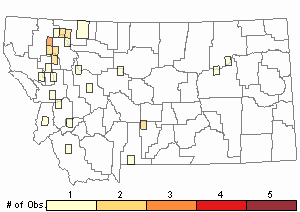
Recency
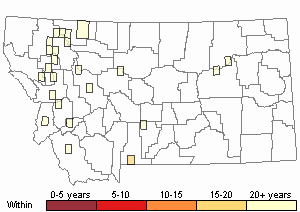
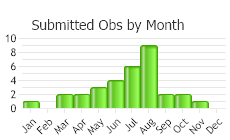
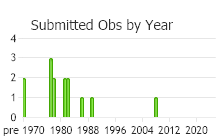
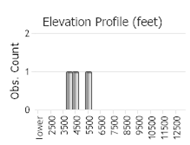 (Observations spanning multiple months or years are excluded from time charts)
(Observations spanning multiple months or years are excluded from time charts)
Habitat
In shaded areas on damp soil (FNA 2014) or humus, sometimes on soil overlying stone, also on rotting logs and tree bark (Lawton 1971). Occurring from lowlands to 8200 feet elevation (FNA 2014).
Reproductive Characteristics
Dioicous. Perichaetial bracts not creating a rosette (FNA 2014). Seta 20-35 mm in height (Lawton 1971). Capsule 3-5 mm in length, russet, tilted (FNA 2014) to nearly drooping (Crum and Anderson et al. 1981), the neck not as long as the rest of the capsule; operculum cone-shaped with a short, abrupt point (Lawton 1971); exostome teeth lance-shaped (FNA 2014), with fine papillae (Lawton 1971); exostome processes similar in height to the teeth, with wide openings on the keel; cilia with short, crosswise ridges. Calyptra draping hood-like, falling away early (FNA 2014).
Specialized vegetative reproduction typically occurring distant from the bottom of the stem
on long rhizoids by rhizoidal tubers, the tubers smooth or nearly so, and russet (similar in color to the rhizoids) (FNA 2014).
Stewardship Responsibility
References
- Literature Cited AboveLegend:
 View Online Publication
View Online Publication Crum, H.A. and L.E. Anderson. 1981. Mosses of Eastern North America. 2 volumes. Columbia University Press, New York. 1328 pp.
Crum, H.A. and L.E. Anderson. 1981. Mosses of Eastern North America. 2 volumes. Columbia University Press, New York. 1328 pp. Elliott, J.C. and A.K. Pipp. 2018. A Checklist of Montana Mosses (1880-2018). Updated 3 January, 2020. Montana Natural Heritage Program, Helena, Montana. 73 pp.
Elliott, J.C. and A.K. Pipp. 2018. A Checklist of Montana Mosses (1880-2018). Updated 3 January, 2020. Montana Natural Heritage Program, Helena, Montana. 73 pp. Flora of North America Editorial Committee, eds. 2014. Flora of North America North of Mexico. Volume 28. Bryophytes: Mosses, Part 2. Oxford University Press, Inc., NY. xxi + 702 pp.
Flora of North America Editorial Committee, eds. 2014. Flora of North America North of Mexico. Volume 28. Bryophytes: Mosses, Part 2. Oxford University Press, Inc., NY. xxi + 702 pp. Lawton, E. 1971. Moss Flora of the Pacific Northwest. Hattori Botanical Laboratory. Japan: Yamabuki-cho, Shinjuku-ku, Tokyo. 362 pages plus appendices.
Lawton, E. 1971. Moss Flora of the Pacific Northwest. Hattori Botanical Laboratory. Japan: Yamabuki-cho, Shinjuku-ku, Tokyo. 362 pages plus appendices.
- Additional ReferencesLegend:
 View Online Publication
View Online Publication
Do you know of a citation we're missing? Aho, Ken Andrew. 2006. Alpine and Cliff Ecosystems in the North-Central Rocky Mountains. Ph.D. Dissertation. Bozeman, Montana: Montana State University. 343 p.
Aho, Ken Andrew. 2006. Alpine and Cliff Ecosystems in the North-Central Rocky Mountains. Ph.D. Dissertation. Bozeman, Montana: Montana State University. 343 p. Elliot, J. C. 1993. Second checklist of Montana mosses. Unpublished report. U.S. Forest Service, Region 1. Missoula, MT. 45 pp.
Elliot, J. C. 1993. Second checklist of Montana mosses. Unpublished report. U.S. Forest Service, Region 1. Missoula, MT. 45 pp. Flowers, S. 1973. Mosses: Utah and the West. Brigham Young University, Provo, Utah. 567 p.
Flowers, S. 1973. Mosses: Utah and the West. Brigham Young University, Provo, Utah. 567 p. Lawton, E. 1971. Keys for the Identification of the Mosses on the Pacific Northwest. Reprinted from 'Moss Flora of the Pacific Northwest'. Published as Supplement No. 2 of the Journal of the Hattori Botanical Laboratory. Nichinan, Miyazaki, Japan. 66 pp.
Lawton, E. 1971. Keys for the Identification of the Mosses on the Pacific Northwest. Reprinted from 'Moss Flora of the Pacific Northwest'. Published as Supplement No. 2 of the Journal of the Hattori Botanical Laboratory. Nichinan, Miyazaki, Japan. 66 pp. Smith, A.J.E. 1980. The Moss Flora of Britain and Ireland. Cambridge University Press, Cambridge. 705 pp.
Smith, A.J.E. 1980. The Moss Flora of Britain and Ireland. Cambridge University Press, Cambridge. 705 pp.
- Web Search Engines for Articles on "Greater Matted Rosulabryum Moss"





